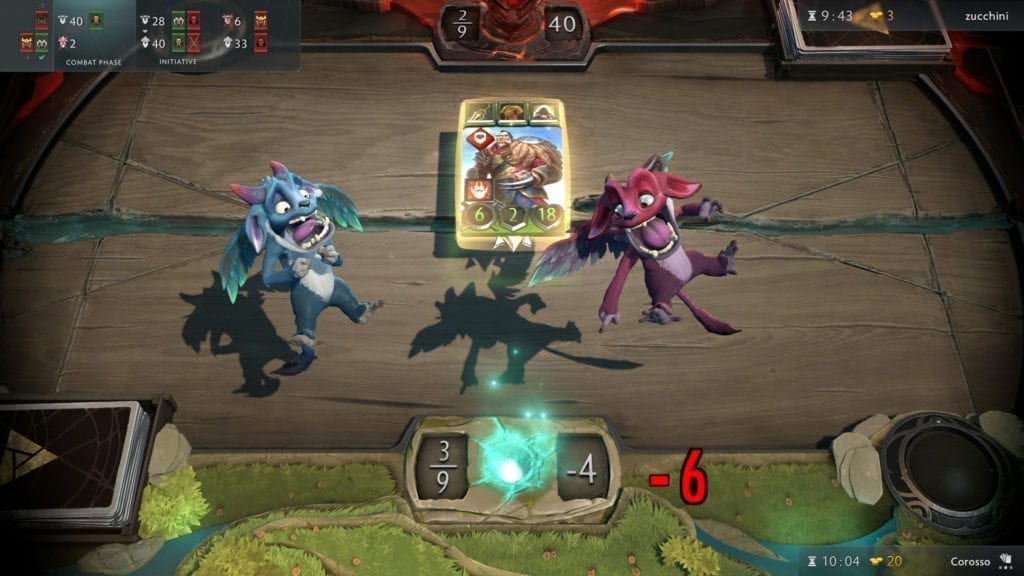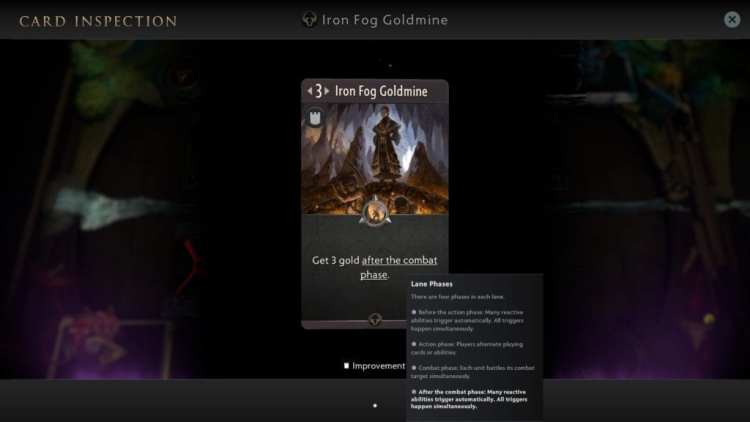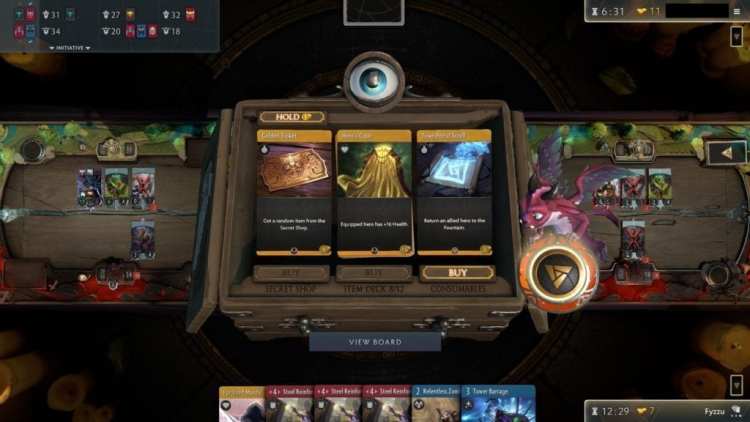Artifact, in case you’ve been living under a rock, is Valve’s combination of the gigantic Dota 2 with the gigantic online card game genre. Not only that, but it’s designed by Richard Garfield – a gigantic name, responsible for the gigantic Magic: The Gathering.
You might say that Artifact is a big deal. Gigantic, even.
But for all of this, it’s not something you can easily just hop into. Even as a CCG, it’s an undeniably unique game, and while the initial tutorials do a good job of helping you muddle through a match, there are plenty of rules and quirks that are never actually expounded upon.
If you’ve played Dota 2, you might have a minor leg-up in terms of understanding some of the unique things Artifact brings to the gaming table. If you’ve played CCGs, then you’ve definitely got more of a grounding in how it’ll work. But it’s got so many unique features and changes that you’ll likely still be rather confused for a little while. For the sake of this, I’ll assume you’ve got at least some experience with Hearthstone, Gwent, or Magic: The Gathering, though.
So, I’m going to go over how to play Artifact, covering some of the more commonly asked questions and going over stuff I wish I knew when I started. I’m not going to teach you how to play it well, because I’m frankly bloody awful, but I have at least figured out how it works.
Artifact‘s Board

The board looks complex, but… well, Artifact is kind of like playing three simultaneous games that slightly interact with each other. So yes, it’s complex. But it’s not as bad as it looks.
The most noticeably huge difference between Artifact and most other CCGs is the board. It’s divided into three entirely separate sections, mirroring the “lanes” of Dota 2.
Each of these three lanes effectively functions as a completely unique playfield, with cards played on one lane unable to affect other lanes. This isn’t strictly true – as with most CCGs (and Dota 2 itself), a lot of the fun comes from cards that bend or break the general rules – but it’s a good rule of thumb.
Each lane also has its own mana pool, which is the resource you use to play cards, as well as its own structures representing your health. So, bearing in mind that each lane doesn’t really interact with the others and that each lane has its own resource for playing cards and its own health, you’re effectively playing three games at the same time… but with one deck of cards.
How To Win
I’m talking victory conditions, here, not how to triumph over your foes. Victory comes when you destroy two of the enemy’s structures, across any lanes. There are actually two ways of doing this.
At the start of the game, every lane contains a tower with 40HP. You can win by destroying two of these towers – in short, by dealing 80HP worth of damage across two separate lanes.
However, when you destroy a tower, that lane isn’t immediately dead. The tower is replaced by the Ancient, which has a fresh health pool of 80HP by itself. As such, it’s possible to win by dominating one lane so hard that you inflict 120HP worth of damage to the structures while successfully defending the other two lanes.
So: either destroy two towers, or expose the enemy Ancient by destroying one tower and then aim for that. Either of these will net you a glorious victory.
Heroes
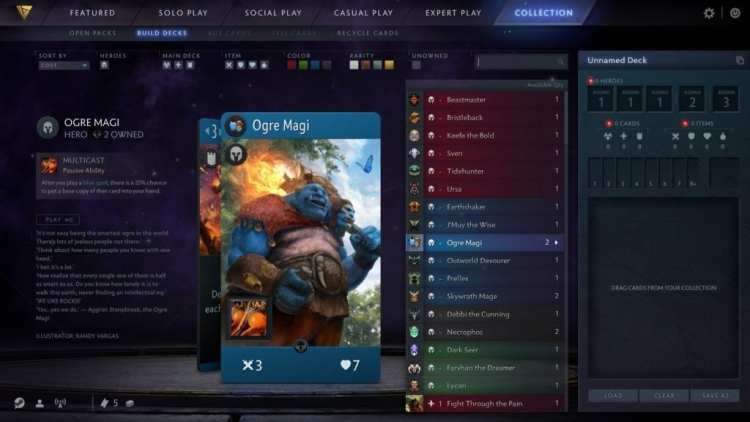
Everyone loves Ogre Magi, especially when he gives you a chance to get your spells back. And yes, every single card has fully voice-acted flavor text.
Because Artifact is based on Dota 2, the obvious centerpiece is the heroes. These named cards represent the characters that you directly control in Dota 2, be it Axe, Necrophos, Bounty Hunter, or dozens of others.
Each deck contains five of these heroes, split between four colors – Red, Green, Blue, and Black. Almost every card in Artifact is tied to one of these colors. It’s up to you how you want to divide them up, but for reasons I’ll explain shortly, it’s usually best to stick to one or two colors in your deck.
Heroes have quirks that make them distinct from other cards. First, each one comes with Signature Cards. Adding the hero to your deck also adds these cards to your deck, representing one of the hero’s signature abilities from Dota 2. For example, Skywrath Mage adds three Mystic Flare cards to your deck, which inflicts 12 damage split evenly between a targeted enemy and its neighbors
Most heroes also have unique quirks, be they passive or active abilities. Abaddon’s Borrowed Time can be used every two turns, and when you activate it, he heals to full and becomes immune to damage for that round. Bristleback’s Barroom Brawler, conversely, is a passive ability, meaning it’s always active. In his case, every time a hero blocking him dies, he gets a permanent +2 armor. Considering his massive base stats of 8 attack and 12 health, you really don’t want your heroes to come up against him.
Heroes can also wear items, which we’ll discuss separately a bit later. But the most important aspect (and the reason why you want to limit the number of colors in your deck) is something else entirely.
Playing Cards

Excellently, plenty of cards have voiced dialogue depending on what you play and what other characters are in lane with them.
Heroes are essentially your avatars in a lane. If you want to play a red card in a lane, you must have a red hero in that lane. If you have a red/blue deck and only have blue heroes in one lane, then all of the red cards in your hand are effectively useless there. As such, to have any real impact in a lane, you need a living hero there – and preferably, you want it to be the same color as the cards in your hand.
Don’t worry, though. If heroes die, they’re out of the game for one round and then can be played into any lane in the next. While it’s advantageous to keep heroes alive, there are times you might want a hero to die so you can redeploy it somewhere else in two turns.
Welcome to the strategic complexities of Artifact.
The Color of Magic
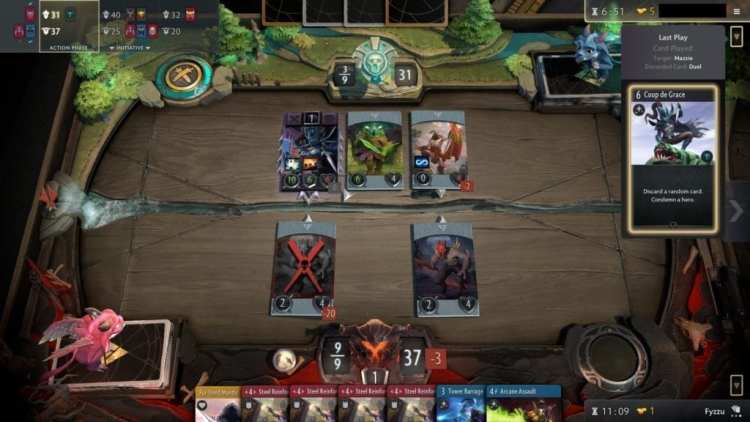
Coup de Grace, Phantom Assassin’s signature card, condemns (read: “instantly kills”) an enemy hero. No questions asked. No armour mitigation. And no saving grace at all, short of a Death Shield. The perfect black card.
I mentioned colors, so I should probably elaborate on what those colors actually mean. Again, there are four: red, green, black, and blue. These don’t correspond to either Magic: The Gathering colors or Dota 2 colors. They’re Artifact unique and are one of the things that’s likely to trip up players of either of those games.
As ever, there are exceptions, but in general:
Red cards focus on outright aggression. Generally, these heroes and creeps have high raw stats that can be buffed even further, either for one turn or permanently. Strong early game, but if they don’t build a decisive advantage they can be outmaneuvered later. Bristleback, for instance, has massive stats and gains extra armor every time he kills a hero blocking him, allowing him to snowball into a killing machine.
Green cards tend to be more about summons, buffs, and heals. They can overwhelm enemies with numbers, strengthen those creeps, and then keep them alive. Chen can take control of enemy creeps, and his Hand of God signature card fully heals allies and gives them immunity to damage for that turn. Meanwhile, Treant Protector offers free Armor to any adjacent allies.
Blue cards are the ones that actually do vaguely resemble Magic and Dota 2. These cards are more about control and powerful spells. While the heroes are fairly weak, they can disarm, silence, and work even fatal situations into their favor with the right cards. See Remote Detonation, which inflicts massive damage to any unblocked enemy.
Black cards are very, very good at killing heroes and maximizing the player’s gold income. With heroes like Bounty Hunter, Phantom Assassin, and Sniper, they can gain extra gold from kills, do absurd levels of damage to heroes, and even deal damage across multiple lanes.
Artifact‘s Card Values

The Ogre Conscript inflicts 7 damage, has 7 health, and all damage directed to it is reduced by 2. Simple enough.
We’d probably better talk a little about how cards actually function, though. All of the creep cards and heroes (the actual units in each lane, basically) have Attack, Armor, and Health values. Attack is how much damage they deal to whatever they’re targeting. Health is, well, how much damage they can take before they die. Finally, Armor mitigates damage. If a card has 2 Armor and is hit by something with 4 Attack, it’ll actually only take 2 damage.
Heroes are also capable of equipping items, which are colorless cards bought with gold (another resource, generally earned by killing enemy units or heroes). Each hero has three slots for gear – a weapon, a piece of armor, and an accessory. By and large, weapons offer more Attack, armor offers more Armor, and accessories offer more Health. They often have secondary effects, though: Blink Dagger gives +2 Attack, but every two turns it lets you move that hero into another lane. Shield of Aquila gives +2 Armor, but allied characters adjacent to it get +3 Armor.
Artifact‘s Card Types
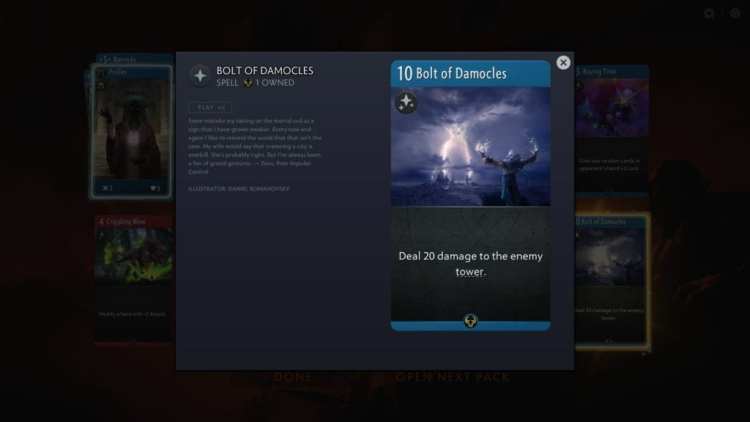
There are plenty of complex spells, but some just fall into the “blow shit up” category. Especially in blue decks.
Before we get into the nitty-gritty about how a turn might play out, let’s talk about the different types of cards. There are five: Heroes, Items, Spells, Creeps, and Improvements.
We’ve talked about heroes. We’ve also talked a bit about items, but other than equipment, there are consumable items. These are things like potions that can restore health to units, and you can play these without a hero in the lane; unlike equipable items, they can also be used on any unit in the lane. If you want to heal a particularly tanky unit but the hero in the lane is dead, that’s fine.
Creep is the official term for units or creatures. Every unit that doesn’t count as a hero is considered a Creep. Confusingly, there are also “Melee Creeps”, which are weak units that are randomly deployed into the lanes at the start of every turn.
Improvements can be best described as lane-specific buffs (although, as with everything else, there are certain Improvements that can impact other lanes). Some might inflict damage on the enemy tower at the start of each turn, or hit a random enemy unit at the start of each turn, or boost that lane’s mana pool permanently. Maybe they automatically create a Melee Creep every turn or boost the Armor of every friendly unit there. Improvements are many and varied, have a lot of possible applications, and require specific cards to get rid of. But once they’re placed, you can’t shift them into another lane later.
Finally, there are Spells. These do, well, everything. Blast an opponent’s tower with a lightning bolt. Temporarily or permanently improve a unit. Summon units. Draw more cards. Deal damage. Move units between lanes. By and large, these are your bread-and-butter cards.
Turn By Turn
So how does Artifact actually play out? Well, after you’re matched up with an opponent, your first three heroes are randomly assigned lanes, along with three Melee Creeps. After that, play proceeds to the left-most lane. This plays out fully, followed by the middle lane, and then finally the right lane.
There are four phases in each lane. First is “Before the action phase”, which is all the stuff that basically triggers as soon as the game shifts to that lane. A variety of abilities play out here – Plague Wards, for instance, will dish out damage to random enemies at this point.
Next is the action phase. Here, players take it in turns to play cards or use abilities: you play something, then your opponent plays something. This goes on until both players pass. It’s worth noting that you can pass, your opponent can play a card, and you can then play something else; passing only stops your actions if your opponent also passes. As such, there is some tactical advantage in passing to try to bait your opponent into playing a card or using an ability… but they may call your bluff and simply pass as well.
This is followed by the combat phase. All units attack their targets simultaneously at this point: they trade punches, things blow up, towers take damage, etc.
Finally, there’s “After the combat phase”, which is when a few other bits and pieces resolve. Some creeps gain stats after the combat round; one improvement gives you bonus gold.
Once that’s done, you move onto the second lane to repeat this, and then the third lane.
Round Two
And then, the first turn ends. This is where things get… a little more confusing. It’s where I wish the tutorials worked a little better.
First up, you get the opportunity to spend your gold. Three items are made available: things from your item deck (a separate set of cards you set up for your deck), consumables like Healing Salves and Town Portal Scrolls, and the Secret Shop, which has a single random – and usually powerful – item up for sale at a high price. You can choose to spend one gold to “hold” the Secret Shop item until the next shopping phase if you so desire.
Next up is deployment. Two Melee Creeps are randomly assigned to lanes, and you can assign any heroes that aren’t already in a lane. On turn two, your fourth hero will be available; on turn three, your fifth. Heroes that have been killed can also be sent back to lanes after spending one full turn dead. Hero assignments are kept hidden from your opponent, so there’s some second-guessing going on here.

This may actually take some deciphering. So, in the middle lane, the incoming melee creep will appear on the left and will be attacking to the right – which means he’ll hit Crystal Maiden. The unblocked Treant Protector, meanwhile, is also attacking to the right. As nothing’s there, he’ll hit the tower.
And this is where things get complicated, because attack directions are chosen. You see, if a unit isn’t directly blocked (as in, if it’s placed without another unit being directly in front of it), it has a chance of attacking in a different direction. Going by what I can dig up on the internet, it’s got a 50% chance of attacking directly in front of it (which, if unblocked, would be the tower/Ancient), a 25% chance of attacking the enemy to the left, and a 25% chance of attacking the enemy to the right. Units are always placed in front of unblocked enemies unless there aren’t any, in which case positioning is randomized. You need to react as much as anything else.
Note that attacks are one-way: an attacking unit won’t take damage unless the other unit is also attacking it. (As with everything else, there are exceptions; Retaliate is a passive ability on some creeps and equipment that inflicts damage to anything attacking it). As such, getting a bit of luck with attack directions can help you take down tough enemies more easily.
Once the deployment phase is over, you’re over to the left lane. At this point, every lane’s maximum mana is increased by one and set to full, and you draw cards. There’s no maximum to the number of cards you can have in your hand, nor is there a limit to the number of units that can be in a lane. I don’t think there’s a limit to the number of Improvements you can have in a lane, either; I’ve had a black deck that wound up with about six or seven Improvements stacked in a single lane.
And then the next turn begins.
Taking The Initiative
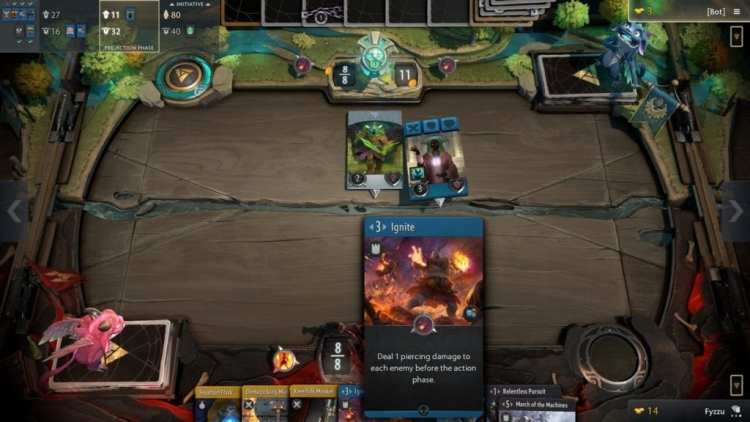
As it’s already the action phase, this isn’t something you’d necessarily need Initiative for as your first card. Of course, if I was going to play it and my blue hero just died because I didn’t have Initiative, and now I can’t…
There are a few really simple things that are easy to overlook – like how good Town Portal Scrolls are, letting you return a hero to your fountain immediately, ready for deployment next turn. (As to why this is good: you can use it to get a hero out of danger, denying your enemy the bounty for killing them, while also letting you move them to another lane where they can have more of an impact, and saving you the turn cooldown while they “respawn”).
That said, Initiative is one of the single most important mechanics in Artifact. Simply put, this determines who goes first in each lane. Considering you can have cards or abilities that can one-shot enemy heroes – possibly preventing your opponent from playing any cards in that lane for that turn – this is massively important.
Initiative comes down to who passes first when each action phase finally ends. If you pass and then your opponent passes, you get the first move in the next lane. Note that this only counts if the turn does end: if you pass, your opponent plays a card, you play a card, your opponent passes, and then you pass, then your opponent will have Initiative.
It’s not as complex as it sounds, honestly. Basically, it’s just “who decided to end the turn first when the turn actually ends”. But it’s definitely something to pay attention to because playing first can have a huge, huge impact.
You’re Going To Suck
Finally, please note that you are going to be terrible. This is as true of Artifact as it is with Dota 2 or Hearthstone or anything else. For the first few dozen hours, you’ll see cards and combinations you haven’t even considered. And they’re going to utterly wreck you. You’ll face off against a black deck with Phantom Assassin and Sniper and Steam Cannons, capable of wiping every hero you have off the face of the earth. (Phantom Assassin does bonus damage when attacking heroes; Sniper can inflict 5 damage to a unit every three turns and his Signature Card lets him do 10 piercing damage, which goes through armor, to a unit in any lane; and Steam Cannon is an Improvement that can do 4 piercing damage to a unit in any lane every turn).
You’ll face red decks that suddenly buff every single one of their heroes to unimaginable levels. Green decks will turn a wave of weak creeps into game-ending world-crushers. Blue decks could completely wipe out every unit you have in a single spell cast. This is going to happen, especially when you’re getting used to Artifact and how it works.
Sorry, but it’s true. But! Every match is a learning experience. Every turn will give you new ideas, new plans, and help you improve.
Artifact is a very, very complex game; moreso than many other online CCGs. That’s not a bad thing. It’s bad that its tutorials are pretty lacking, but there’s a huge amount of depth and uniqueness here. Hopefully, I’ve helped you avoid some of the more common pitfalls.

